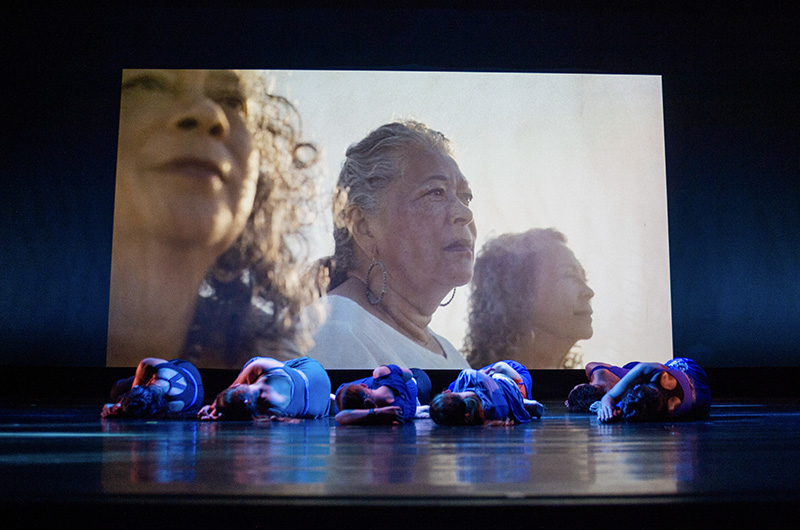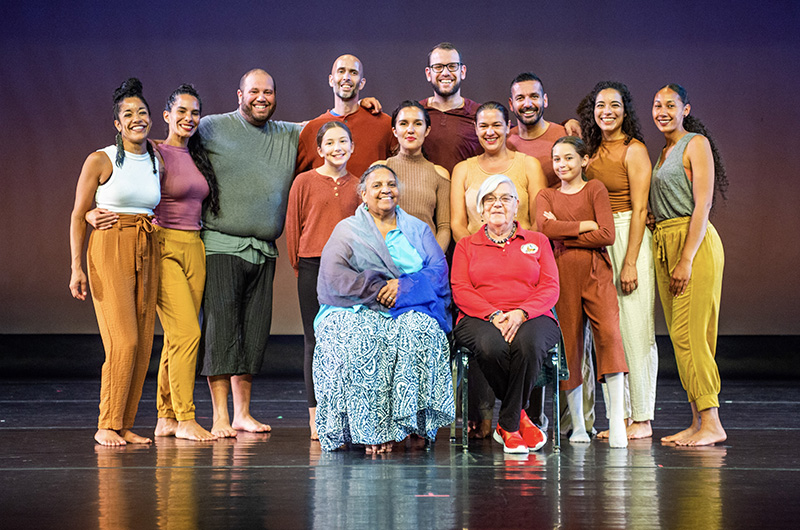Tribal descendants from Martha’s Vineyard and Puerto Rico brought their shared history to the stage Saturday afternoon in a powerful and uplifting work in progress piece that blended dance, film and spoken word.
Emphasizing the bond between humanity and nature that was the essence of the pre-colonial Island experience, Âs Nupumukâunean (We Still Dance) was suffused with the rhythms of the sea and of native music, played and sung onstage by Aquinnah Wampanoag tribal members Carole Vandal, Durwood Vanderhoop and James Moreis.
All of the musicians also danced alongside more than half a dozen other Wampanoag members and four professionals from Danza Orgánica, a Boston-based dance company led by Mar Parrilla.
Ms. Parrilla, who traces her lineage to the pre-colonial Taino people of Borikèn (Puerto Rico), and her troupe have been working with members of the Aquinnah tribe for more than four years to develop the piece, under the auspices of The Yard.
“They do this work at night and on weekends,” said Yvonne Mendez, acting executive director and program director at the Yard, as she introduced Saturday’s performance at the Martha’s Vineyard Performing Arts Center in Oak Bluffs.
The partnership began after Aquinnah tribal elder Kristina Hook attended a performance by Danza Orgànica during its 2018 residency at the Yard and recognized her own tribe’s experience in the Puerto Rican dancers’ narrative of colonization and survival in the hundreds of years since the European conquest.
“I knew it was our story. I knew it was every first-contact people’s story,” Ms. Hook said, during a question and answer session following Saturday’s show.
Ms. Hook also appeared in the performance, with her own lyrical retelling of a Wampanoag tribal legend. When Moshup departed the Island, Ms. Hook told the audience, he gave his people their choice of remaining on land and taking their chances with an uncertain future, or becoming part of the sea world instead.
“When we were little we heard these stories and it was a given that we could have been whales,” she said.
“What a great thought for a child! I could have been a whale, but I am not a whale — my ancestors chose to stick it out,” Ms. Hook continued.
Even without changing their physical form, the Wampanoag retained their intimacy with the natural world: “If we can hear the ocean, if we can hear the wind … we are a part of it. Our ancestors, who were whalers that were sought after because of that connection, were all aware of that at some level,” Ms. Hook said.
The blended company of Puerto Rican professionals and Wampanoag locals — the latter aged 11 and up — brought that natural balance alive on the performing arts center stage in movements evoking the endless waves of Island seas and the strength of the communal hunt.
Death and loss also made their appearance, particularly in a soundless scene danced by Jannette Vanderhoop as a loving, then mourning mother, and another featuring Ms. Vandal, who performed an expressive solo of grief with her shawl while seated in a chair.
But the overall effect of Âs Nupumukâunean (We Still Dance) was of strength, survival and cultures that remain alive despite hundreds of years of oppression.
One especially heart-lifting scene paired the two youngest Wampanoag dancers, 11-year-old Oceana Arroyo Dias and 12-year-old Kaya Rutkowski, in learning tribal dance steps from their elders, first from behind a scrim and then together in front of it.
The other Aquinnah cast members were Ella Mahoney — who also designed and painted the program’s silk banners of Moshup, whales and the natural world — NaDaizja Bolling and Michael Sellitti Jr., who also served as a narrator.
Several other Aquinnah tribal members collaborated on the work, according to the program.
Interspersed during the show’s two nearly half-hour parts were short films interviewing tribal elders such as Berta Giles Welch, filmed with her sisters Adriana Giles Ignacio and Carla Giles Ignacio above the Gay Head Cliffs, and Donald Widdiss, in his wampum studio.
Keeping the native tradition alive through generations is important, said Mr. Widdiss, whose son Jason has followed his footsteps as a wampum jeweler.
But being native does not make one a museum piece, the performance’s final act made clear.
“The world has changed. So have we,” said Mr. Sellitti, before the entire troupe exploded into motion to the recorded song Land Back, by Canadian hip hop/electronica group The Halluci Nation (formerly A Tribe Called Red).
Ms. Hook then returned to the stage with a few final words.
“This is not the end,” she told the audience. “We continue to struggle to find our place in a more respectful world.”











Comments (1)
Comments
Comment policy »